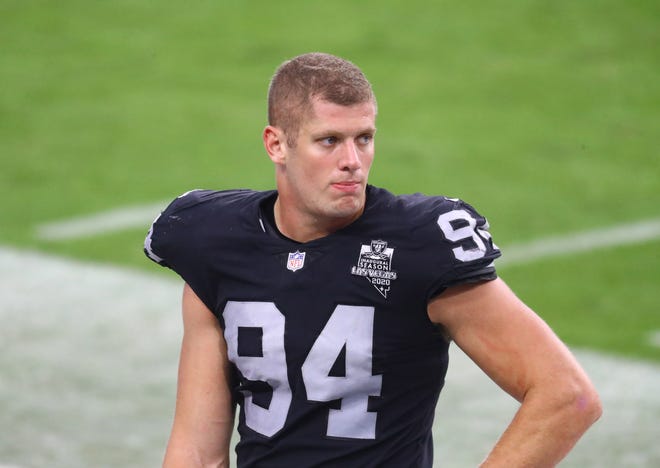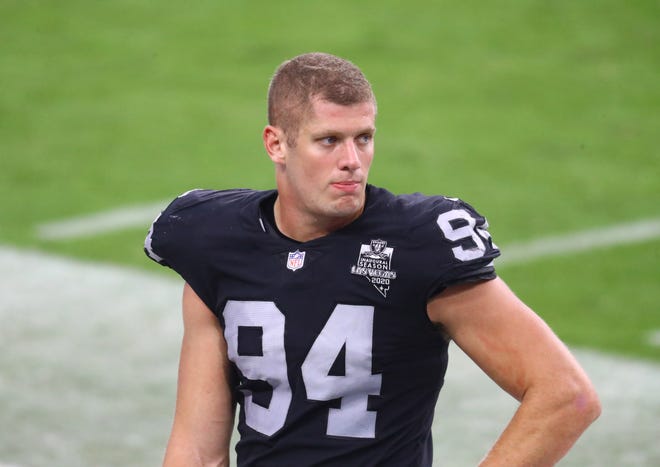Former Dallas Cowboys linebacker Jeff Rohrer said Las Vegas Raiders defensive end Carl Nassib could change the world after becoming the first active openly gay NFL player.
Rohrer would know. He played in the NFL from 1982 to 1989, and in 2018, he came out as gay when he became what was believed to be the first former or current NFL player to enter into a same-sex marriage.
“He has no idea how many people he’s affecting – in a good way,” Rohrer said. “The NFL needed this, to get past the milestone. In the long run, the world we live in needs more guys like (Nassib) who are open and brave. It really does help for anyone in the country who is currently closeted or faces homophobia.”
Sarah Kate Ellis, CEO of the advocacy organization GLADD, said Nassib’s journey will “not only have a profound impact on the future of LGBTQ visibility and acceptance in sports, but send a strong message to so many LGBTQ people, especially youth.”
Yet the biggest foreseeable challenge for Nassib, 28, could be his own world that is about to change – becoming a beacon of hope for closeted athletes everywhere – and managing the national spotlight that comes with his sexual orientation being front and center.

“He’s going to be asked questions about being gay now until the end of his career. That’s what he’s signing up for,” Rohrer said. “We can only hope the message to others of his experience remains positive.”
Will more closeted NFL players or professional athletes follow in Nassib’s footsteps now? Experts say it could be more of a wait-and-see approach vs. an immediate domino effect.
“He’s humanizing an issue that needed humanizing,” said licensed clinical psychologist Dr. Susan Wilson, who was a treatment clinician for the NFL and counseled numerous closeted players. “But there are several things that make it challenging to come out. Football is a very masculine, macho sport. Being gay in that environment embedded in homophobia is not easy.”
Michael Sam came out as gay before being selected in the seventh round of the 2014 NFL draft but never played a game in the NFL. And free agent Ryan Russell came out as bisexual in 2019. But Nassib already has a portion of his future secured, having just signed a three-year contract with the Raiders in March 2020. He was a third-round pick in the 2016 draft and has played in 73 games.
MIKE FREEMAN:Carl Nassib’s coming out doesn’t just make history. Raiders DL could save lives
“This is almost a guaranteed success story,” said Cyd Zeigler, co-founder of LGBTQ sports online magazine Outsports. “The most meaningful thing he did was come out over Instagram in a video because it showed the truth of his demeanor. He spoke with such joy and ease, and that showed the relief you feel from being yourself with family and friends supporting you.”
Nassib is receiving support from many places. Former Kansas State player Scott Frantz, the first Power 5 college football player to compete while openly gay, told USA TODAY Sports he messaged Nassib to express his gratitude: “Thanks for doing what you did. You don’t know how much pressure that relieved off my shoulders. I felt like I failed our community when I couldn’t make it to the NFL.”
NFL Commissioner Roger Goodell said in a statement: “We share his hope that someday soon statements like (Nassib’s) will no longer be newsworthy.”
“Coming out as gay is going to continue to be a big deal or news story for athletes until it’s a regular occurrence,” said Ryan O’Callaghan, who came out after retiring in 2017. “We’re not there yet.”
O’Callaghan, who wrote the book “My Life on the Line” in 2019, said that this will be Nassib’s story to tell and that the spotlight can follow his authenticity.
Wilson, who helped O’Callaghan on his coming-out journey when he was with the Kansas City Chiefs, said the fear that many closeted athletes face is, indeed, based on harsh realities.
“Players feel that all of the sudden camaraderie with several players disappear because of being gay. The psychological aspect of coming out, facing fear of abandonment and potentially losing their career, is most prominent,” Wilson said. “As a clinician I have to tell them how things could go good, but also how things could go bad. Because families have disowned players when they come out, and people act in ways that are so sadly disappointing when they hear you’re gay.”
Former Arizona State lineman Chip Sarafin, who in 2014 became the first NCAA Division I football player to come out, said he felt that type of contempt from people close to him. But despite homophobic language still prevalent in locker room culture, Sarafin said, teammates probably won’t be a concern for Nassib.
“It’s going to be a continuous coming-out journey for him every single day by being in the spotlight,” Sarafin said. “But much of that will be because of the outside world. I expect his teammates to love him for who he is as a person and player, to see it as one shade of who he is.”
Rohrer said: “All my paranoia and thoughts and beliefs when I was closeted turned out to be wrong. I had two people of a thousand who didn’t act well. I can only hope that’s the case for Carl.”


